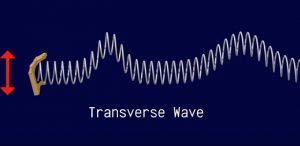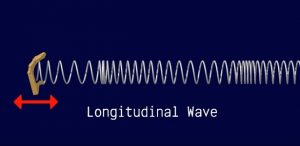Traveling waves
18 Wave basics
Wave analogy
Scientists have found that waves provide an excellent analogy for understanding many of the behaviors of sound (and light and other things). Before getting into the details about how sound is like a wave, it is useful to look at waves we can visualize- like water waves and waves on slinkies.
Mechanical waves

Waves on a slinky are an example of a mechanical wave. As you wiggle up and down on a slinky, pulses move away from your hand, travel through the slinky and are eventually felt at the other end of the slinky. Careful observation of a slinky yields some important conclusions about mechanical waves. First, vibrations cause waves. Second, mechanical waves need a material to travel through (called the medium).

There are two primary types of waves- transverse waves and longitudinal waves. In transverse waves, vibrations move perpendicular to the wave itself. The “wave” at the football stadium is an example of a transverse wave. People stand up and sit down, but the wave moves around the stadium. You can also make T-waves easily on a slinky- stretch the slinky along the floor and wiggle the end of the slinky side to side. The coils on the spring move left and right while the wave travels away from you. In longitudinal waves, the vibrations move parallel to the wave itself. To make a L-wave in the classroom, you form a conga line, with one person holding the shoulders of the person in front of them. The person at the back of the line pushes forward on the next person to start the wave. Each person moves forward and backward as the wave travels to the front of the line. To make an L-wave with the slinky, you must push and pull in and out on the end of the slinky. L-waves are sometimes called compression waves.
This short (0:24) youtube video [1] shows the difference between L- and T-waves on a slinky. The two pictures in this section are screen shots from that video.
Sound is a longitudinal wave
Sound is a longitudinal wave. Sources of a sound move in and out, compressing and stretching the material in front of them. This wave motion animation [2] on Daniel Russell’s website at Penn State shows how air molecules move in a sound wave (in air).
What moves in a wave?
A close look at waves in a slinky reveals something important about mechanical waves- particles in the medium vibrate, but they do not move along with the wave. Send a pulse along a slinky and you’ll notice that individual coils of the spring move up and down but never stray far from their original location. It’s like “the wave” at the football stadium. People stand up and sit down, never leaving their seat, but the wave travels around the stadium. This is an important feature for all mechanical waves- individual molecules in the medium vibrate, but never travel very far from their original location. The vibration travels long distances- individual particles don’t. This explains, for instance, why ducks on a pond bob up and down as waves go by, rather than move along with the crests. The same thing happens in a sound wave. Look at the highlighted air particles on Dan Russell’s wave motion animation– notice that the highlighted particles vibrate in place as the wave crosses the screen.
Some people think of sound as being like wind- a group of air particles moving from place to place. The idea is illustrated in a famous 1980s era commercial for Maxell brand audio tape. A man sits in a chair as loud music plays through a speaker near the left side of the picture. As the music plays, the man’s hair (tie, drink, and pretty much everything else) are all blown to the right across the screen. We’re supposed to believe the speaker creates a wind. This idea is wrong: the air molecules in a sound wave do not travel along with the sound! Each air molecule in the room vibrates, but stays in essentially the same place. Each air molecule disturbs its neighbor and it is the disturbance that crosses the room- not the air. The wind in the commercial is, in fact, caused by a large fan just off screen. If sound worked like a wind, we might expect to be able to spread perfume faster by putting an open bottle in front of a speaker with loud music. It simply doesn’t work. Perfume spreads just as slowly with the music as without it.
Stop to think
A loudspeaker is on stage in a quiet auditorium. Joe sits at the back of the auditorium. Suzy sits about halfway between Joe and the speaker. A particle of dust is in the air somewhere close to Suzy’s ear when the speaker blasts a short blast of 400 Hz tone.
- How does the dust particle move while Suzy hears the sound?
- How does the dust particle move after Suzy hears the sound?
- Where is the dust particle when Joe hears the sound?
Stop to think answer
While Suzy hears the sound, the dust particle wiggles back and forth along the line of travel of the sound (towards and then away from the stage). The particle’s oscillation is pretty quick (400 oscillations per second). Once the sound passes, the particle stops moving, ending up essentially where it started (near Suzy’s ear). So, when Joe hears the sound a short time later, the particle is still very close to Suzy’s ear. It is the sound that moves from place to place- not the air.
Online resources
Watch What does sound look like? [3] (2:31 youTube video). This short piece produced for NPR shows high speed video of several common sounds and explains the technique used to produce the videos.
Image credits
- Transverse wave on a slinky. (Screenshot from [1]; original is CC-BY-NC)
- Longitudinal wave on a slinky. (Screenshot from [1]; original is CC-BY-NC).
- Animations for Physics and Astronomy. (2012, February 7). Longitudinal and Transverse Waves. Retrieved from https://youtu.be/UHcse1jJAto ↵
- Russell, D. (1988, August 5). Wave Motion. Retrieved from http://www.acs.psu.edu/drussell/Demos/waves/wavemotion.html ↵
- SkunkBear (2014, April 9). What does sound look like? Retrieved from https://youtu.be/px3oVGXr4mo. ↵
